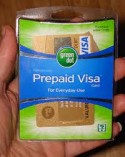 One of the first questions many people ask about prepaid cards is usually, “How do you use it?”. Simply put, you just load money that has already been earned by you onto a plastic or virtual card and then use it in the same way you would use a network-branded credit card like Visa or MasterCard. Easy, right? Well, just like anything these days, it takes a little understanding of the prepaid product to get the most out of it. Before using the card for purchases, ATM withdrawals or paying your bills, you have to understand how to actually load money on the card.
One of the first questions many people ask about prepaid cards is usually, “How do you use it?”. Simply put, you just load money that has already been earned by you onto a plastic or virtual card and then use it in the same way you would use a network-branded credit card like Visa or MasterCard. Easy, right? Well, just like anything these days, it takes a little understanding of the prepaid product to get the most out of it. Before using the card for purchases, ATM withdrawals or paying your bills, you have to understand how to actually load money on the card.
Here are six basic ways to accomplish loading funds on a prepaid debit card:
Direct Deposit – This can be one of the most advantageous loads as many card companies offer incentives such as FREE monthly fees or even cash bonuses to sign up. Typically, you can set up direct deposit from a paycheck, government benefits check or even a tax refund. When you visit a prepaid card website like the NetSpend MasterCard, there will be a direct deposit form that you have to print and fill out with pertinent personal information. This form can be delivered to your employer’s payroll department, uploaded on the U.S. Treasury website (or other government entity that oversees benefits payments) or even administered through your CPA if you have a Green1040 prepaid debit card. You can monitor your deposits and perform account maintenance on almost all prepaid card websites.
Green Dot Load Network – One of the most popular reload networks is Green Dot. The Green Dot MoneyPak is available at over 50,000 retail merchants nationwide including Walgreens, CVS, Rite Aid, Kroger, Radio Shack, K-mart, Meijer and 7-Eleven (to mention a few). The challenging issue with using reload cards like MoneyPak are that you have to load funds first on the MoneyPak card and THEN again on the previously purchased prepaid card. Also, every load costs around $5 and usually there is a load limit of around $500, then you will have get another MoneyPak to load additional funds.
Retail Load Networks – Popular prepaid cards like the AccountNow Visa give you several alternatives for loading funds through a variety of reload networks such as – MoneyGram, Western Union, Visa ReadyLink and Green Dot as well. Usually, there are financial service merchants occupying a retail space at your favorite intersection that offer load and reload services for a fee. Several other brand names you may run across include – ACE Express, CashPass, PayZone, PreCash, PayPower and ReloadIT.
Bank Account Transfer – Prepaid cards like the Purple Diamond RushCard Visa not only allows you to use load methods as those previously described, but you can also set up a transfer via online bill pay through your bank. Some cards will also accept a check, wire transfer or money order. Not all prepaid products offer load options to individuals with traditional banks accounts. Always check to make sure.
Credit Card or PayPal Funds Transfer – Credit card transfers onto a prepaid card are somewhat rare although some cards do offer it. Loading funds online through a PayPal account is more widely accepted including prepaid cards such as the Mango MasterCard. With Mango, you simply login to your online Mango account and click on the tab that says “Add Money” and select “Pay Pal”. And Mango doesn’t charge a fee to receive transfers from your PayPal account.
Card-to-Card Money Transfer – Companion and student cards are becoming more and more popular these days for parents to not only transfer funds, but educate children in some of the finer aspects of financial management. Cards like the BillMyParents Spend Smart MasterCard are setting new levels in value-added services in mobile transaction tracking, account alerts, online budgeting and remote card authorization control. The financial safety above that of carrying cash, along with the added technological value make prepaid cards like this a great tool for many families.
There can be nuances and variations found in various prepaid cards when it come to the loading and reloading of funds. These are six of the most common ways, although we always encourage our readers to research all of the best methods for themselves as every product is different in some way.
Comments are closed